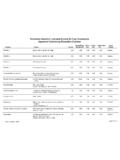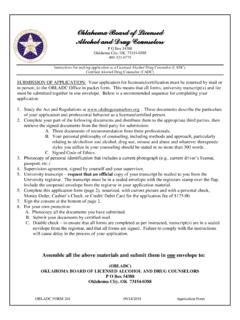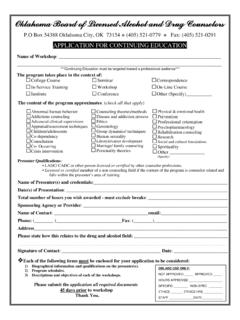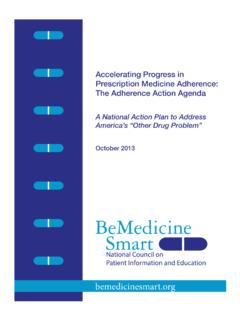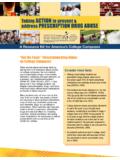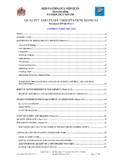Transcription of GENERAL SUPERVISION EVALUATION FORM FOR DRUG AND …
1 OBLADC form 208 11/2012 1 GENERAL SUPERVISION EVALUATION form FOR DRUG AND ALCOHOL LICENSURE/CERTIFICATION ELIGIBILITY LADC - Typically 50 completed hours of educational SUPERVISION / 2000 completed hours of practice/work hours under SUPERVISION CADC - Typically 100 completed hours of educational SUPERVISION / 4000 completed hours of practice/work hours under SUPERVISION LADC/MH - Typically 50 completed hours of educational SUPERVISION / 2000 completed hours of practice/work hours under SUPERVISION PARTIAL SUPERVISION (Due to a change in status, change of SUPERVISION , change of employment): Number of completed hours of SUPERVISION this EVALUATION :_____ Hours to present date: _____ SUPERVISEE Other name(s) under which evaluations have been submitted Home Address - Street/City/State/Zip Home E-Mail Home Phone ( ) Employing Agency Position Position is: Full Time Part-Time: Number of hours per week: Agency Address Street/City/State/Zip Agency E-Mail Agency Phone ( ) SUPERVISOR License Number Job Title Agency Phone ( ) Employing Agency Agency E-Mail Agency Address Street/City/State/Zip PERIOD OF SUPERVISION .
2 From _____ To _____ (Month/Day/Year) (Month/Day/Year) Total hours of Individual* & Group** SUPERVISION this EVALUATION : Total hours of Individual* & Group** SUPERVISION to present date: * no more than 2 people can be considered individual SUPERVISION . ** the group size must be limited to no more than 6 people OKLAHOMA STATE BOARD OF ALCOHOL AND DRUG COUNSELORS PO Box 54388 -- Oklahoma City, OK 73154-0388 Phone: (405) 521-0779 Fax: (405) 521-0291 OBLADC form 208 11/2012 2 Degree(s) Certifications / Licensures How many years have you been involved in the Behavioral Science field as a clinician? _____ How many years have you been working with Alcoholism and/or drug abuse clients?
3 _____ How long have you known the applicant? _____ How long have you supervised/consulted with the applicant? _____ Describe the procedure you have used to supervise/consult the applicant. _____ _____ (Attach additional sheets if necessary) EVALUATION of competencies required for certification COMPETENCIES REQUIRED FOR CERTIFICATION TO BE EVALUATED Poor Excellent 1 2 3 4 5 1. Skill in motivating the client to actively participate in counseling session; 1 2 3 4 5 2. Skill in the client intake process. 1 2 3 4 5 A. Individual Counseling. 1. Building rapport with the client 1 2 3 4 5 2.
4 Identifying and working through defense mechanisms: 1 2 3 4 5 3. Maintaining control of counseling situations: 1 2 3 4 5 4. Showing respect for self and client: 1 2 3 4 5 5. Eliciting client feelings and problems: 1 2 3 4 5 6. Providing feedback to client on emotions and attitudes expressed: 1 2 3 4 5 OBLADC form 208 11/2012 3 Continued from page 2 7. Assisting the client in recognizing and assuming responsibility for his/her own behavior: Poor Excellent 1 2 3 4 5 8. Assisting the client in developing positive life skills: 1 2 3 4 5 9.
5 Utilizing one or more treatment modalities: 1 2 3 4 5 10. Counseling termination process. 1 2 3 4 5 Group Counseling. 1. Facilitating the adoption of an open stance and a willingness to communicate among group members: 1 2 3 4 5 2. Exercise appropriate leadership of group activities: 1 2 3 4 5 3. Assisting group members in expressing their feelings and reactions and giving and receiving feedback: 1 2 3 4 5 4. Assisting group members to gain awareness for interactions with the group and explore alternative responses to interpersonal situations: 1 2 3 4 5 5.
6 Facilitating group members in sharing experiences, concerns and strategies with one another. 1 2 3 4 5 6. Cooperating with co-facilitator, when available, in planning, conducting and critiquing sessions. 1 2 3 4 5 Working with client s family and significant others 1. Establishing contact with members of the client s family: 1 2 3 4 52. Seeking input from client s family to aid in the overall EVALUATION and development of a treatment plan for client: 1 2 3 4 5 3. Acting as a buffer between client, the client s family or significant others: 1 2 3 4 5 4.
7 Identifying positive and negative contributions to the alcohol and/or drug problem: 1 2 3 4 5 5. Assisting family and significant others to recognize their own roles, dysfunctional behaviors and capabilities: 1 2 3 4 5 6. Acquainting family and significant others with basic information on alcohol and other drugs: 1 2 3 4 5 7. Assisting family and significant others in developing productive behaviors: 1 2 3 4 5 OBLADC form 208 11/2012 4 Client Intake and Screening Insofar as possible, obtaining complete and accurate account of client s problems and history, including his/her work history and family relationships as well as his/her drinking/drug pattern and the kinds of problems that result from that drinking/drug pattern.
8 Complete an EVALUATION assessing cultural implications, spirituality, education, socio-economic status and current emotional state: Poor Excellent 1 2 3 4 5 Formulating Client Treatment Plans 1. Reviewing and interpreting exiting records of clients 1 2 3 4 5 2. Informing clients of their human and legal rights in treatment: 1 2 3 4 5 3. Working with clients to plan treatment and discussing treatment plans with client during counseling sessions: 1 2 3 4 5 COMPETENCIES REQUIRED FOR CERTIFICATION TO BE EVALUATED 1 2 3 4 5 4. Assessing needs and problems of client: 1 2 3 4 5 5.
9 Sharing EVALUATION findings with client and working thorough client reactions or resistance to this EVALUATION or progress. 1 2 3 4 5 6. Recognizing situations which are beyond the counselor s ability and referring such individuals to an appropriate resource. 1 2 3 4 5 Referrals 1. Suggesting referrals appropriate for the client: 1 2 3 4 5 2. Contacting and/ or contracting with other persons, agencies, or groups for services and progress reports: 1 2 3 4 5 3. Explaining to the client the referral resource and its function in relationship to his/her problem: 1 2 3 4 5 4. Assure that client will feel free to return to the counselor for further assistance if the referral resource is inadequate: 1 2 3 4 5 5.
10 Recognizing serious medical, psychological or spiritual situations which are beyond his/her expertise and referring the client promptly and appropriately: 1 2 3 4 5 Post Treatment Planning and Aftercare 1. Assessment of client s current status: 1 2 3 4 5 2. Preparation of after-care plan: 1 2 3 4 5 3. Assisting client to implement post-treatment plan: 1 2 3 4 5 4. Preparation to termination or discharge summary. 1 2 3 4 5 Staff Conferences and Interactions 1. Maintain effective communication with other staff members: 1 2 3 4 5 2. Function as a part of a treatment team: 1 2 3 4 5 3.

